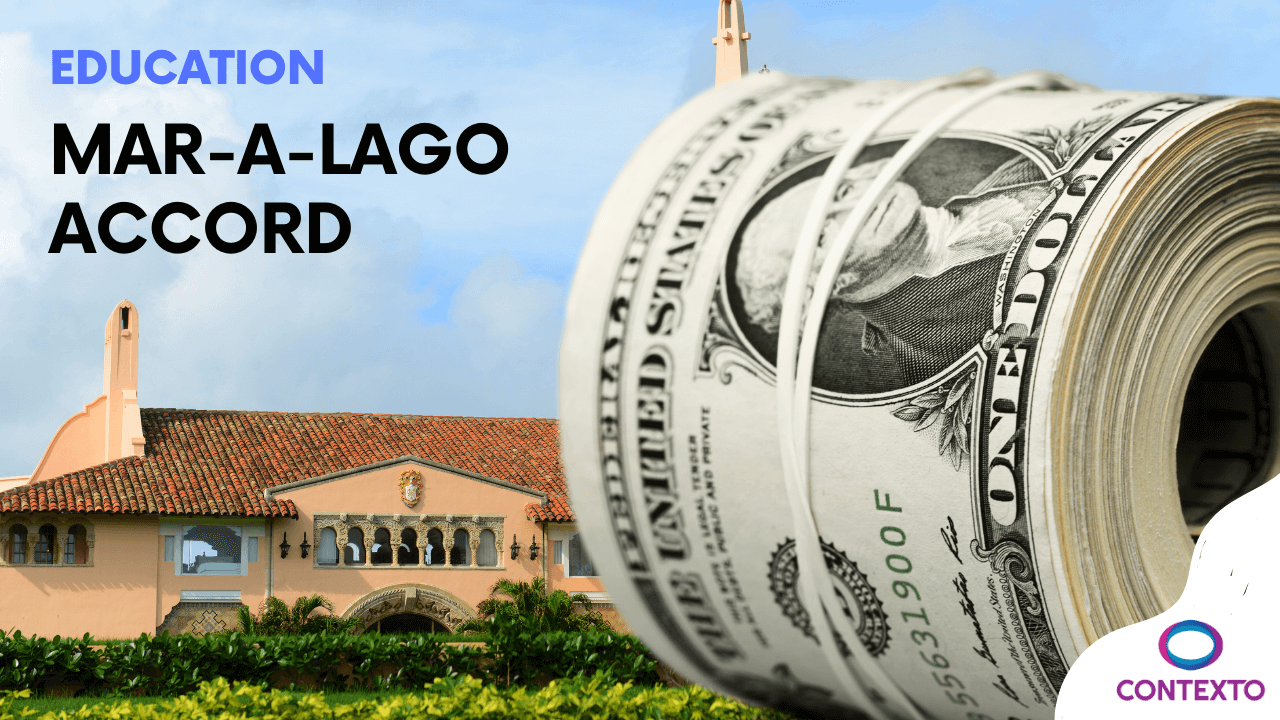A new chapter in the global economy?
The Mar-a-Lago Accord is an emerging proposal that has gained attention in global economic circles. Inspired by historic agreements like the 1944 Bretton Woods Agreement and the 1985 Plaza Accord, this initiative seeks to restructure the global financial system to meet the current economic needs of the United States.
Named after former President Donald Trump’s luxurious Mar-a-Lago resort, the proposal was outlined by Stephen Miran, Trump’s former nominee to the White House Council of Economic Advisers. But what exactly does this agreement aim to achieve, and why is it so important?
Contexto histórico: ¿Qué fueron Bretton Woods y el Acuerdo Plaza?
Para comprender la importancia del Tratado de Mar-a-Lago, es fundamental revisar dos eventos clave de la historia financiera internacional:
-
El Acuerdo de Bretton Woods (1944): Firmado al final de la Segunda Guerra Mundial, estableció las bases del sistema financiero global moderno. Dio origen al Fondo Monetario Internacional (FMI) y al Banco Mundial, y fijó las monedas al dólar estadounidense, el cual era convertible en oro. Este sistema trajo estabilidad económica hasta su colapso en los años 70.
-
El Acuerdo Plaza (1985): Un esfuerzo conjunto de las cinco principales economías del momento (EE.UU., Japón, Alemania Occidental, Francia y Reino Unido) para depreciar el dólar, que estaba demasiado fuerte y afectaba las exportaciones estadounidenses. Aunque tuvo éxito en debilitar el dólar, también provocó efectos negativos a largo plazo, como la burbuja económica que afectó gravemente a Japón.
Muchos analistas ven el Tratado de Mar-a-Lago como un intento moderno de replicar y actualizar estas estrategias históricas.
The theoretical foundation: Stephen Miran’s article
In November 2024, economist Stephen Miran published an article that would later become the theoretical foundation of the Mar-a-Lago Accord. In the text, Miran argued that the U.S. economy was facing structural imbalances caused by a strong overvalued dollar, dependence on foreign financing, and an unsustainable debt structure.
His proposal focused on two pillars:
- A controlled devaluation of the dollar to increase U.S. export competitiveness
- Restructuring short-term debt into ultra long-term bonds to ease the federal financial burden
This article sparked interest among Trump-aligned economists and laid the groundwork for what would evolve into the Mar-a-Lago Accord.
Background of the Mar-a-Lago Accord
The proposal officially emerged following Miran’s article and seeks to devalue the dollar and convert short-term debt into long-term bonds, with the goal of improving trade balance and reducing interest payment burdens.
As the global demand for dollars increases, the Mar-a-Lago Accord is framed as a strategy to correct currency imbalances and revitalize U.S. manufacturing.
Main Goals of the Mar-a-Lago Accord
1. Controlled dollar devaluation
Inspired by the Plaza Accord, this proposal aims to strategically weaken the dollar to make U.S. exports more affordable.
2. National debt restructuring
By turning short-term debt into ultra-long-term instruments, the plan seeks to reduce annual interest expenses and ease pressure on the federal budget.
3. Strengthening domestic manufacturing
A weaker dollar would enhance the global competitiveness of American-made goods, promoting industrial growth and job creation.
4. International cooperation
The accord envisions a multilateral agreement involving major economies such as China, Japan, and the EU to coordinate global economic stability.
Challenges and risks
Despite its ambition, the Mar-a-Lago Accord faces major hurdles:
1. International resistance
Countries like China may be reluctant to participate due to fears of domestic economic repercussions, similar to Japan’s post-Plaza Accord experience.
2. Complexity of debt restructuring
Convincing foreign creditors to exchange current bonds for long-term ones could prove diplomatically and financially complex.
3. Financial market volatility
Policy shifts in currency and debt strategy may lead to instability in global financial markets in the short term.
Conclusion
The Mar-a-Lago Accord represents an ambitious attempt to redefine U.S. economic strategy and reshape the international financial system. By proposing dollar devaluation and national debt reform, it aims to boost domestic industry and rebalance trade.
However, its success will depend on international negotiations and the willingness of major economies to collaborate on a shared financial restructuring effort.
References:
- Bloomberg Línea Brasil
- Financial Times
- Investment News
- Nasdaq
- Invezz
- Newstarget.com
- Stephen Miran’s article (November 2024)










Leave A Comment